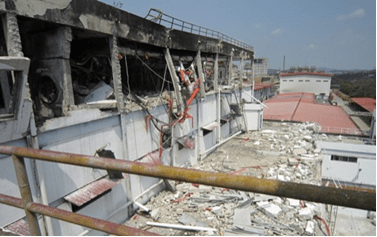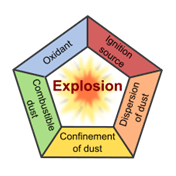AHU System Installation Exploded And Catched Fire

AHU (Air Handling Unit) system installed on the highest floor of a polymer processing factory building exploded and catched fire, causing three workers nearby the area sustained injuries. Accident was suspected to start in a return quench air room, where the return air from the process work carried out in the building is channeled before being released into the air. Inspections had found a lot of fine dust (olygomer) produced from the process work carried out in the building was accumulated in the return quench air room and return quench air ducting.
In this case, explosions and fires are likely to occur when the following five elements are fulfilled:
|
 |
Therefore, any industries that use or produce dust substances must take measures to avoid an explosion and fire to happen, especially those caused by these substances. Among the actions should be taken are:
- identify the physical and chemical properties of substances used or prodeced from the undertaking process work whether it is able to cause an explosion or fire hazard. MSDS review is one of the mechanism that can be used for this purpose.
- conduct inspections on the machinery and installations used in each process work, particularly in areas where dust accumulation are likely to occur, for example air ducting, ceilings and any confined space.
- identify appropriate and effective control measures, based on the risk assessment been carried out. Control measures should be able to avoid, or at least minimize the risk and consequences of the event. Among the control measures that can be implemented are:
- control of combustible dust
- minimize the escape of dust from process work or ventilation systems
- use dust collection systems and filters - control of ignition source
- use electrical equipment and wiring methods that are safe and comply to standard requirement
- control static electricity
- control of combustible dust
- conduct inspection, audit and preventive maintenance on the implemented control measures, to monitor and verify functionality and effectiveness of the controls measures. It should be done regularly and frequently to ensure the identification and rectification of any problems encountered can be made promptly.
- establish an effective housekeeping program to control dust accumulation at any location within the plant including the machineries, air ducting, confined spaces and others. Appropriate cleaning methods should be set accordingly and based on the risks that might occur.
- improve hazard communication programs so that the hazards of combustible dust are clearly identified and communicated to the workers. Programs such as training and awareness to workers can be carried out in accordance with this requirements, to ensure important and updated information can be delivered to them.
References:
- Circular on the Hazards and Controls of Combustible Dusts – Ministry of Manpower, Singapore.
- Instructors Manual: Combustible Dust - Safety and Injury Prevention – Kirkwood Community College.
- Hazardous or Combustible Dusts, Fumes and Fibres – Government of Western Australia.